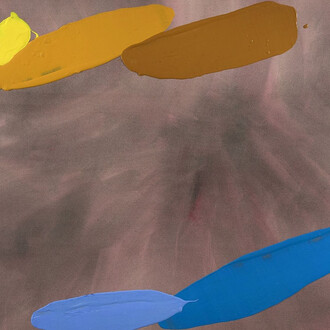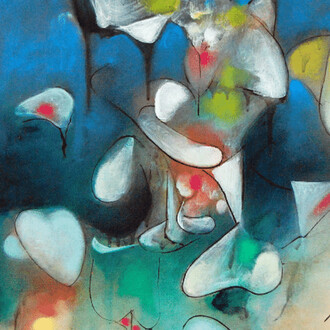DC Moore Gallery is pleased to present Jacob Lawrence: Builders, an exhibition showcasing paintings, drawings, and prints by the iconic 20th-century artist Jacob Lawrence, spanning from 1974-2000. Jacob Lawrence (1917-2000) holds a unique place in 20th-century art, blending figurative, narrative, and abstract elements to explore significant social and philosophical themes. His work, particularly his engagement with African American subjects, was groundbreaking. During the last three decades of his life, Lawrence devoted himself to the Builders theme, a continuation of his focus on daily life and a testament to his belief in human agency and the dignity of work. The Builders series symbolizes various ideas about life and work, particularly within Black communities, offering philosophical reflections on the human condition and emphasizing the role and responsibility of individuals in societal improvement.
In 1998, Lawrence created a series of twelve paintings on the Builders theme, which were first exhibited at DC Moore Gallery in the fall of that year. Four of these paintings are included in the current exhibition. Lawrence employed a method he devised for his narrative series on Black history, where he first determined the overall concept, sketched each composition in pencil, and then applied color simultaneously to all the works. The paintings are visually dynamic, characterized by strong primary colors, tilted perspectives, precisely cut-out forms, and the interplay of large, blocky objects with smaller, intricate ones. Throughout the works, Lawrence uses arrangements of tools to create dynamic compositions, often exaggerating their size or depicting them hanging off tables as if weightless.
Lawrence kept a collection of vintage hand tools in his studio, such as wood planers and other carpentry tools, a selection of which are included in this exhibition. “Many hand tools haven’t changed for centuries,” Lawrence once said. “They have such balance and are so functional. The human body is like a tool. Any living thing has this kind of structure.” In his paintings, he often portrayed builders’ hands as overly large, emphasizing the physical effort, power, and skill that he associated with creativity and progress. Through the connection between the hand and the tool, Lawrence celebrated the work of carpenters, drawing a parallel between their labor and that of artists, both requiring coordination of the mental and the manual, the mind and the hands.
This connection between the body and tools is also expressed in Lawrence’s figure drawings. In the 1970s, his interest in the Builders theme led him to explore figure drawing. Inspired by the scientific drawings of Vesalius, a 16th-century doctor, Lawrence created drawings of the human form as a structural entity rather than an expressive one. In these drawings, figures stand in minimal environments with carpenter’s tools and wooden boards, with the lines and angles of the tools echoing the lines of the human forms.
Running through the works is an exploration of Lawrence’s identity. He saw himself as one among many using their talent to contribute to societal improvement. The 1994 print Artist in studio reveals Lawrence’s self-identification with the builder, depicting an artist working on an image of a man holding tools. The artist’s brushes are oversized, emphasizing their use as tools. On the windowsill, a hammer, a saw, and a bowl of fruit—objects that frequently recur in Lawrence’s Builders compositions—are depicted. For Lawrence, the image of fruit in a bowl symbolized the attainment of life’s necessities and pleasures.
The works in this exhibition showcase the artist’s continued growth, expanding imagery, and unwavering commitment to telling the stories of working people's lives. Like his earlier historical series, the Builders series is socially motivated, offering deeply personal perspectives on hope, agency, collaboration, and progress.
Jacob Lawrence (1917-2000) is represented in major museum collections across the United States. Recent major solo exhibitions of his work include Jacob Lawrence: the american struggle (The Peabody Essex Museum, Massachusetts, 2020; traveled to the Birmingham Museum of Art, Alabama, The Seattle Art Museum, Washington; the Metropolitan Museum of Art, New York, and The Phillips Collection, Washington, D.C.); Black Orpheus: Jacob Lawrence and the Mbari Club (Chrysler Museum of Art, Virginia, 2022; traveled to the New Orleans Museum of Art, Louisiana, and Toledo Museum of Art, Ohio); and One way ticket: Jacob Lawrence’s migration series at the Museum of Modern Art, New York, 2020.
















